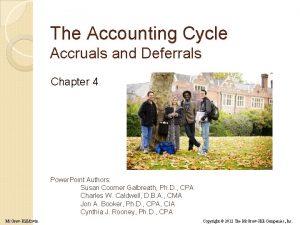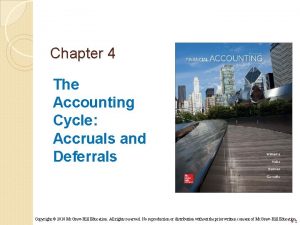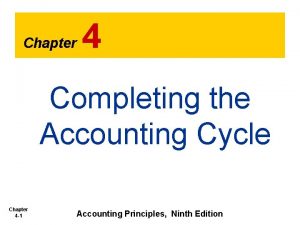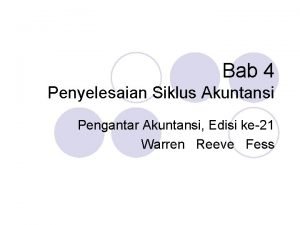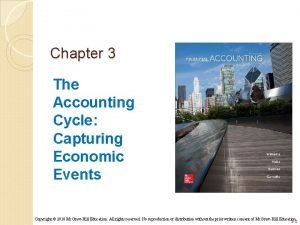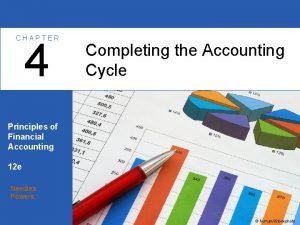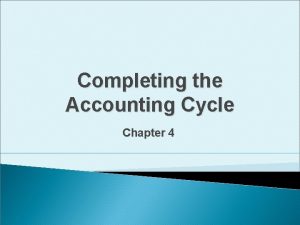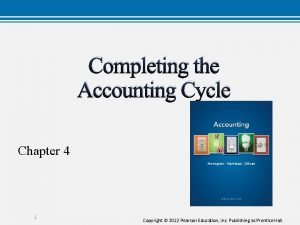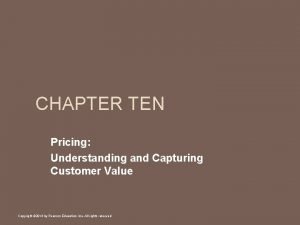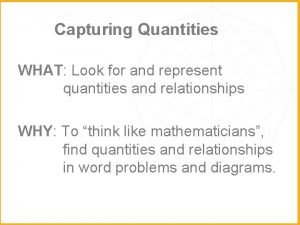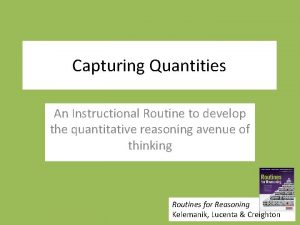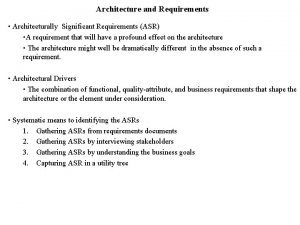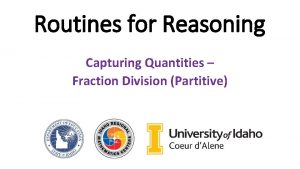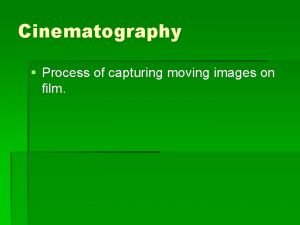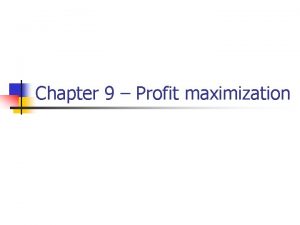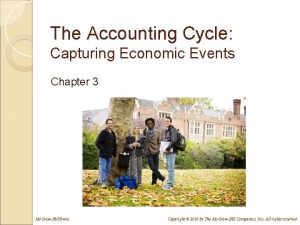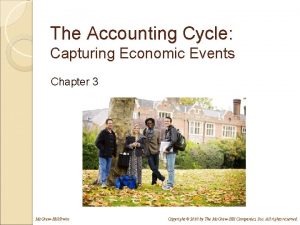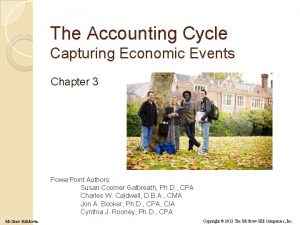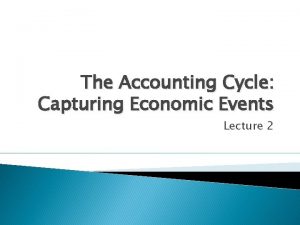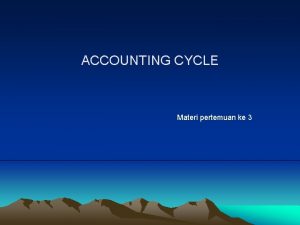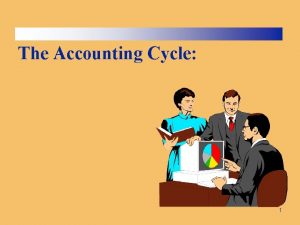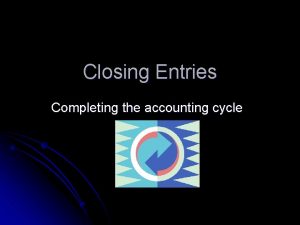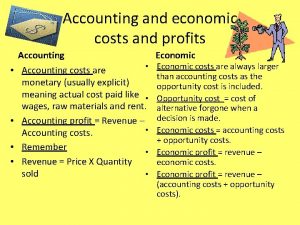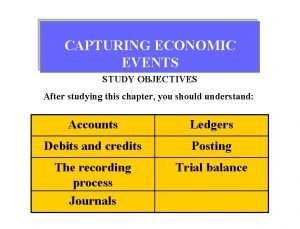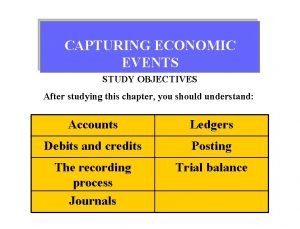Chapter 3 The Accounting Cycle Capturing Economic Events












































































- Slides: 76

Chapter 3 The Accounting Cycle: Capturing Economic Events Copyright © 2018 Mc. Graw-Hill Education. All rights reserved. No reproduction or distribution without the prior written consent of Mc. Graw-Hill Education. 3 -1

The Accounting Cycle Accounting records are used to: ◦ Prepare financial statements. ◦ Complete income tax returns. ◦ Create other reports. The accounting cycle is the sequence of accounting procedures used to record, classify, and summarize accounting information in financial reports at regular intervals. 3 -2

Steps of the Accounting Cycle 1. 2. 3. 4. 5. 6. 7. 8. Journalize (record) transactions. Post each journal entry to ledger accounts. Prepare a trial balance. Make end-of-period adjusting entries. Prepare adjusted trial balance. Prepare financial statements. Journalize and post closing entries. Prepare after-closing trial balance. 3 -3

Role of Accounting Records Managers and employees of a business frequently use the information stored in the accounting records for the following: 1. Establishing accountability for the assets and/or transactions under an individual’s control. 2. Keeping track of routine business activities. 3. Obtaining detailed information about a particular transaction. 3 -4

Role of Accounting Records (cont. ) 4. Evaluating the efficiency and performance of various departments within an organization. 5. Maintaining documentary evidence of the company’s business activities including regulatory requirements such as tax compliance and documentation. 3 -5

The Ledger Account: the record used to keep track of the increases and decreases in financial statement items; may also be called a “ledger account. ” Ledger: the accounting record which includes the entire group of individual accounts. 3 -6

The Use of Accounts Each account has three elements: 1. A title 2. A left side, which is called the debit side 3. A right side, which is called the credit side KEY POINT Whether an account is increased or decreased by a debit or credit entry will depend on the account type (i. e. asset, liability, etc. ). We will learn more about this throughout the chapter. 3 -7

Using T Accounts Increases are recorded on one side of the T account, and decreases are recorded on the other side. Title of Account Left or Debit Side Right or Credit Side 3 -8

Debit and Credit Entries Receipts are on the debit side. Payments are on the credit side. The balance is the difference between the debit and credit entries in the account. 3 -9

Rules of Debit and Credit Entries Debits and credits affect accounts as follows: A = L + OE ASSETS Debit for Credit for Increase Decrease LIABILITIES OWNERS’ EQUITY Debit Credit for for Decrease Increase 3 -10

Debit Balances in Asset Accounts Asset accounts are increased by debit entries and decreased by credit entries. Asset accounts have a normal debit balance. The fact that assets are located on the left side of the balance sheet is a convenient means of remembering the rule that an increase in an asset is recorded on the left (debit) side of the account and an asset account normally has a debit (left-hand) balance. 3 -11

Credit Balances in Liabilities and Equity Liability accounts and owners’ equity accounts are increased by credits and decreased by debits. The relationship between entries in these accounts and their position on the balance sheet may be summed up as follows: 1. Liabilities and owners’ equity belong on the right side of the balance sheet. 2. An increase in a liability or an owners’ equity account is recorded on the right (credit) side of the account. 3. Liability and owners’ equity accounts normally have credit (right-hand) balances. 3 -12

Debit and Credit Rule Summary 3 -13

Double-Entry Accounting The Equality of Debits and Credits A = L + OE = Debit balances Credit balances In the double-entry accounting system, every transaction is recorded by equal dollar amounts of debits and credits. 3 -14

The Journal In an actual accounting system, the information about each business transaction is initially recorded in an accounting record called the journal. The journal is a chronological (day-by-day) record of business transactions. This information is later transferred to the appropriate accounts in the general ledger. 3 -15

The Journal (cont. ) At convenient intervals, the debit and credit amounts recorded in the journal are transferred (posted) to the accounts in the ledger. The updated ledger accounts, in turn, serve as the basis for preparing the company’s financial statements. 3 -16

Example: Transaction 1 On January 20, 2018, the Mc. Bryan family invested $80, 000 in exchange for capital stock. Thus, the asset Cash increased by $80, 000, and the owners’ equity account Capital Stock increased by the same amount. Applying the debit and credit rules discussed previously, we know that increases in assets are recorded by debits, whereas increases in owners’ equity are recorded by credits. As such, this event requires a debit to Cash and a credit to Capital Stock in the amount of $80, 000. 3 -17

Example: Transaction 1 (cont. ) GENERAL JOURNAL Date Account Titles and Explanation Debit Cash 80, 000 Credit 2018 Jan. 20 Capital Stock 80, 000 Owners invest cash in the business. Note the basic characteristics of this general journal entry. 1. The name of the account debited (Cash) is written first, and the dollar amount to be debited appears in the lefthand money column. 2. The name of the account credited (Capital Stock) appears below the account debited and is indented to the right. The dollar amount appears in the right-hand money column. 3. A brief description of the transaction appears immediately below the journal entry. 3 -18

Posting Journal Entries to the Ledger Posting simply means updating the ledger accounts for the effects of the transactions recorded in the journal. Posting involves copying into the ledger accounts information that already has been recorded in the journal. KEY POINT In manual accounting systems, this can be a tedious and timeconsuming process, but in computer-based systems, it is done instantly and automatically. In addition, computerized posting greatly reduces the risk of errors. 3 -19

Posting the Journal Entry to Cash 3 -20

Posting the Journal Entry to Capital Stock 3 -21

Summary of January 20 Entry 3 -22

Summary of January 21 Entry Representing Overnight, Mc. Bryan negotiated with both the City of Santa Teresa and Metropolitan Transit Authority (MTA) to purchase an abandoned bus garage. (The city owned the land, but the MTA owned the building. ) On January 21, Overnight Auto Service purchased the land from the city for $52, 000 cash. 3 -23

Summary of January 22 Entry Overnight completed the acquisition of its business location by purchasing the abandoned building from the MTA. The purchase price was $36, 000; Overnight made a $6, 000 cash down payment and issued a 90 -day, non-interest-bearing note payable for the remaining $30, 000. 3 -24

Summary of January 23 Entry Overnight purchased tools and equipment on account from Snappy Tools. The purchase price was $13, 800, due in 60 days. 3 -25

Summary of January 24 Entry Overnight found that it had purchased more tools than it needed. On January 24, it sold the excess tools on account to Ace Towing at a price of $1, 800. The tools were sold at a price equal to their cost, so there was no gain or loss on this transaction. 3 -26

Summary of January 26 Entry Overnight received $600 in partial collection of the account receivable from Ace Towing. 3 -27

Summary of January 27 Entry Overnight made a $6, 800 partial payment of its account payable to Snappy Tools. 3 -28

Ledger Accounts after Posting T accounts are simplified versions of the ledger account that only show the debit and credit columns. 3 -29

What Is Net Income? Net income is not an asset it’s an increase in owners’ equity from profits of the business. A = L + OE Increase Decrease As income is earned, either an asset is increased or a liability is decreased. Increase Net income always results in the increase of Owners’ Equity. 3 -30

Retained Earnings A = L + OE Capital Stock Retained Earnings The balance in the Retained Earnings account represents the total net income of the corporation over the entire lifetime of the business, less all amounts which have been distributed to the stockholders as dividends. 3 -31

Overnight’s Income Statement OVERNIGHT AUTO SERVICE INCOME STATEMENT FOR THE YEAR ENDED DECEMBER 31, 2018 Revenue: Repair service revenue $172, 000 Rent revenue earned 3, 000 Total revenue $175, 000 Expenses: Advertising $3, 900 Salaries and wages 58, 750 Supplies 7, 500 Depreciation: building 1, 650 Depreciation: tools and equipment 2, 200 Utilities 19, 400 Insurance 15, 000 Interest Income before income taxes Income taxes Net income 30 108, 430 $66, 570 26, 628 $39, 942 3 -32

Case in Point The late J. Paul Getty, one of the world’s first billionaires, was once interviewed by a group of business students. One of the students asked Getty to estimate the amount of his income. As the student had not specified a time period, Getty decided to have some fun with his audience and responded, “About $11, 000. ” He paused long enough to allow the group to express surprise over this seemingly low amount, and then completed his sentence, “an hour. ” 3 -33

Accounting Period Terminology Accounting period—the period of time covered by an income statement. Time period principle—net income is measured for relatively short accounting periods of equal length to facilitate the interpretation of financial events and the preparation of financial statements. Fiscal year—the 12 -month accounting period used by an entity. 3 -34

Revenue is the price of goods sold and services rendered during an accounting period. ◦ Causes owners’ equity to increase. ◦ Results in an increase in cash or accounts receivable. ◦ Represents the gross increase in owners’ equity resulting from operation of the business. 3 -35

Realization Principle The realization principle indicates that revenue should be recognized at the time goods are sold or services are rendered. ◦ The business must have essentially completed the earnings process. ◦ The sales value of the goods or services can be measured objectively. 3 -36

Expenses are the costs of the goods and services used up in the process of earning revenue. ◦ Examples include the cost of salaries, advertising, rent, utilities, and depreciation of long-term assets. ◦ Necessary to attract and serve customers. ◦ Causes a decrease in owners’ equity. ◦ Results in either a decrease in assets or an increase to liabilities (accounts payable). 3 -37

The Matching Principle The matching principle refers to the concept of offsetting expenses against revenue on a basis of cause and effect. ◦ Expenses are incurred for the purpose of producing revenue. ◦ In order to measure net income for a period, revenue should be offset by all the expenses incurred in producing that revenue. 3 -38

Expenditures Benefiting More Than One Accounting Period Many expenditures made by a business benefit two or more accounting periods. ◦ Examples may include insurance policies, buildings, machinery, and equipment. ◦ Assuming that management can reasonably estimate the number of accounting periods that will benefit, the cost should be recorded as an asset and allocated to expense over the period for which it will benefit the company. 3 -39

International Case in Point International financial reporting standards (IFRSs) differ significantly from U. S. GAAP with respect to costs that are expensed immediately and costs that are capitalized. For example, IFRS 38 allows development costs to be capitalized if certain criteria are met, but under U. S. GAAP these same costs would need to be expensed in the period in which they occur. Conversely, advertising costs are expensed as incurred under IFRS, whereas under some limited circumstances advertising costs can be capitalized under U. S. GAAP. 3 -40

Accrual Basis of Accounting Accrual basis of accounting has two basic requirements: 1. Revenue is recognized in the period when it is earned. 2. Expenses are recognized in the period when they are incurred. Most important concept is the matching principle. Revenue is offset with all of the expenses incurred in generating that revenue, thus providing a measure of the overall profitability of the economic activity. 3 -41

Cash Basis of Accounting Under the cash basis of accounting: ◦ Revenue is recognized when cash is collected. ◦ Expenses are recognized when payments are made. Cash basis measures the amount of cash received and paid out during the period. The cash basis does not provide a good measure of profitability during the period. KEY POINT The cash basis of accounting is not permitted under U. S. GAAP. 3 -42

Cash Flow vs. Income Statement Recognition 3 -43

Debit and Credit Rules for Revenue and Expenses The debit and credit rules for recording revenue and expenses in the ledger accounts are a natural extension of the rules for recording changes in owners’ equity: Increases in owners’ equity are recorded by credits. Decreases in owners’ equity are recorded by debits. This rule is now extended to cover revenue and expense accounts. Revenue increases owners’ equity; therefore, revenue is recorded by credits. Expenses decrease owners’ equity; therefore, expenses are recorded by debits. 3 -44

Revenue and Expense T Accounts Expenses decrease owners’ equity. EQUITIES Debit Credit for Decrease Increase Revenues increase owners’ equity. EXPENSES REVENUES Debit Credit for Increase Debit Credit for Decrease Increase 3 -45

Dividends A dividend is a distribution of assets (usually cash) by a corporation to its stockholders. ◦ Reduces both assets and owners’ equity. ◦ Is not classified as an expense. ◦ Represents a distribution of profits to the owners of the business. 3 -46

Dividends (cont. ) Payments to owners decrease owners’ equity. EQUITIES Debit Credit for Decrease Increase DIVIDENDS Debit Credit for Increase Decrease Owners’ investments increase owners’ equity. CAPITAL STOCK Debit Credit for Decrease Increase 3 -47

Income Statement Transactions Illustrated In the following slides, we will continue our analysis of Overnight Auto Service by examining their transactions related to: ◦ Revenue ◦ Expense ◦ Dividends 3 -48

Summary of January 31 Transaction Recorded revenue of $2, 200, all of which was received in cash. 3 -49

Summary of January 31 Entry 2 Paid employees’ wages earned in January, $1, 200. 3 -50

Summary of January 31 Entry 3 Paid for utilities used in January, $200. 3 -51

February 1 Transaction Paid Daily Tribune $360 cash for newspaper advertising to be run during February. 3 -52

February 2 Transaction Purchased radio advertising from KRAM to be aired in February. The cost was $470, payable within 30 days. 3 -53

February 4 Transaction Purchased various shop supplies (such as grease, solvents, nuts, and bolts) from CAPA Auto Parts; the cost was $1, 400, due in 30 days. These supplies are expected to meet Overnight’s needs for three or four months. 3 -54

February 15 Transaction Collected $4, 980 cash for repairs made to vehicles of Airport Shuttle Service. 3 -55

February 28 Transaction 1 Billed Harbor Cab Co. $5, 400 for maintenance and repair services Overnight provided in February. The agreement with Harbor Cab calls for payment to be received by March 10. 3 -56

February 28 Transaction 2 Paid employees’ wages earned in February, $4, 900. 3 -57

Your Turn You as Overnight Auto Service’s Accountant Your good friend, Fred Jonas, is the manager of Harbor Cab Co. Your family and Fred’s family meet frequently outside of your respective workplaces for fun. At a recent barbecue, Fred asked you about the amount of repair services rendered by Overnight Auto to Airport Shuttle Services in February. Airport Shuttle Services competes with Harbor Cab Co. for fares to and from the airport. What should you say to Fred? 3 -58

February 28 Transaction 3 Recorded $1, 600 utility bill for February. The entire amount is due March 15. 3 -59

February 28 Transaction 4 Overnight Auto Services declares and pays a dividend of 40 cents per share to the owners of its 8, 000 shares of capital stock—a total of $3, 200. 3 -60

Overnight’s Trial Balance All balances are taken from the ledger accounts on Feb. 28 after considering all of Overnight’s transactions for the month. 3 -61

Uses and Limitations of the Trial Balance The trial balance provides proof that the ledger is in balance. The agreement of the debit and credit totals of the trial balance gives assurance that: 1. Equal debits and credits have been recorded for all transactions. 2. The addition of the account balances in the trial balance has been performed correctly. KEY POINT The preparation of a trial balance does not prove that transactions have been correctly analyzed and recorded in the proper accounts. It is still possible that an entry was posted to incorrect account(s) or that an entry was omitted all together. 3 -62

Locating Errors on the Trial Balance Suppose that the debit and credit totals of the trial balance do not agree. This situation indicates that one or more errors have been made. Typical of such errors are: 1. Post of a debit as a credit or vice versa. 2. Mathematical mistakes in computing account balances. 3. Clerical errors in copying account balances. 4. Listing a debit balance in the credit column or vice versa. 5. Errors in addition of the trial balance. 3 -63

Computers Improve Efficiency Computers now free accountants to focus upon the more analytical aspects of their discipline. These include, for example: ◦ Determining the information needs of decision makers. ◦ Designing systems to provide the information quickly and efficiently. ◦ Evaluating the efficiency of operations throughout the organization. 3 -64

Computers Improve Efficiency (cont. ) ◦ Assisting decision makers in interpreting accounting information. ◦ Auditing (confirming the reliability of accounting information). ◦ Forecasting the probable results of future operations. ◦ Tax planning. 3 -65

Learning Objective Summary LO 3 -1: Identify the steps in the accounting cycle and discuss the role of accounting records in an organization. The accounting cycle generally consists of eight specific steps: (1) journalizing (recording) transactions, (2) posting each journal entry to the appropriate ledger accounts, (3) preparing a trial balance, (4) making end-of-period adjustments, (5) preparing an adjusted trial balance, (6) preparing financial statements, (7) journalizing and posting closing entries, and (8) preparing an after-closing trial balance. 3 -66

Learning Objective Summary LO 3 -2: Describe a ledger account and a ledger. A ledger account is a device for recording the increases or decreases in one financial statement item, such as a particular asset, a type of liability, or owners’ equity. The general ledger is an accounting record that includes all the ledger accounts—that is, a separate account for each item included in the company’s financial statements. 3 -67

Learning Objective Summary LO 3 -3: Understand how balance sheet accounts are increased or decreased. Increases in assets are recorded by debits and decreases are recorded by credits. Increases in liabilities and in owners’ equity are recorded by credits and decreases are recorded by debits. Notice that the debit and credit rules are related to an account’s location in the balance sheet. If the account appears on the left side of the balance sheet (asset accounts), increases in the account balance are recorded by left-side entries (debits). If the account appears on the right side of the balance sheet (liability and owners’ equity accounts), increases are recorded by right-side entries (credits). 3 -68

Learning Objective Summary LO 3 -4: Explain the double-entry system of accounting. The double-entry system of accounting takes its name from the fact that every business transaction is recorded by two types of entries: (1) debit entries to one or more accounts and (2) credit entries to one or more accounts. In recording any transaction, the total dollar amount of the debit entries must equal the total dollar amount of the credit entries. 3 -69

Learning Objective Summary LO 3 -5: Explain the purpose of a journal and its relationship to the ledger. The journal is the accounting record in which business transactions are initially recorded. The entry in the journal shows which ledger accounts have increased as a result of the transaction and which have decreased. After the effects of the transaction have been recorded in the journal, the changes in the individual ledger accounts are then posted to the ledger. 3 -70

Learning Objective Summary LO 3 -6: Explain the nature of net income, revenue, and expenses. Net income is an increase in owners’ equity that results from the profitable operation of a business during an accounting period. Net income also may be defined as revenue minus expenses. Revenue is the price of goods sold and services rendered to customers during the period, and expenses are the costs of the goods and services used up in the process of earning revenue. 3 -71

Learning Objective Summary LO 3 -7: Apply the realization and matching principles in recording revenue and expenses. The realization principle indicates that revenue should be recorded in the accounting records when it is earned—that is, when goods are sold or services are rendered to customers. The matching principle indicates that expenses should be offset against revenue on the basis of cause and effect. Thus, an expense should be recorded in the period in which the related good or service is consumed in the process of earning revenue. 3 -72

Learning Objective Summary LO 3 -8: Understand how revenue and expense transactions are recorded in an accounting system. The debit and credit rules for recording revenue and expenses are based on the rules for recording changes in owners’ equity. Earning revenue increases owners’ equity; therefore, revenue is recorded with a credit entry. Expenses reduce owners’ equity and are recorded with debit entries. 3 -73

Learning Objective Summary LO 3 -9: Prepare a trial balance and explain its uses and limitations. In a trial balance, separate debit and credit columns are used to list the balances of the individual ledger accounts. The two columns are then totaled to prove the equality of the debit and credit balances. This process provides assurance that (1) the total of the debits posted to the ledger was equal to the total of the credits and (2) the balances of the individual ledger accounts were correctly computed. While a trial balance proves the equality of debit and credit entries in the ledger, it does not detect such errors as failure to record a business transaction, improper analysis of the accounts affected by the transaction, or the posting of debit or credit entries to the wrong accounts. 3 -74

Learning Objective Summary LO 3 -10: Distinguish between accounting cycle procedures and the knowledge of accounting. Accounting procedures involve the steps and processes necessary to prepare accounting information. A knowledge of the discipline enables one to use accounting information in evaluating performance, forecasting operations, and making complex business decisions. 3 -75

End of Chapter 3 3 -76
 Mutually exclusive events vs not mutually exclusive events
Mutually exclusive events vs not mutually exclusive events Financial accounting chapter 1
Financial accounting chapter 1 Economic growth vs economic development
Economic growth vs economic development Growth and development conclusion
Growth and development conclusion Lesson 2 our economic choices
Lesson 2 our economic choices Chapter 4 the accounting cycle accruals and deferrals
Chapter 4 the accounting cycle accruals and deferrals Chapter 4 the accounting cycle accruals and deferrals
Chapter 4 the accounting cycle accruals and deferrals Chapter 4 completing the accounting cycle
Chapter 4 completing the accounting cycle Chapter 4 completing the accounting cycle answers
Chapter 4 completing the accounting cycle answers Chapter 4 completing the accounting cycle
Chapter 4 completing the accounting cycle Chapter 3 accounting cycle
Chapter 3 accounting cycle Chapter 4 completing the accounting cycle
Chapter 4 completing the accounting cycle Accounting cycle
Accounting cycle Accounting cycle
Accounting cycle Chapter 4 completing the accounting cycle
Chapter 4 completing the accounting cycle Capturing kids hearts four questions
Capturing kids hearts four questions Kevin kotler net worth
Kevin kotler net worth Capturing customer mindset
Capturing customer mindset Creating and capturing customer value
Creating and capturing customer value Excel capturing kids hearts
Excel capturing kids hearts A device used for capturing images
A device used for capturing images Capturing reality documentary
Capturing reality documentary Pricing: understanding and capturing customer value
Pricing: understanding and capturing customer value Qualitative research techniques to measure brand equity
Qualitative research techniques to measure brand equity Capturing quantities
Capturing quantities Capturing quantities
Capturing quantities What is data capturing with example
What is data capturing with example Capturing architectural requirements
Capturing architectural requirements Capturing quantities
Capturing quantities Types of lev
Types of lev The process of capturing moving images on film
The process of capturing moving images on film Data capturing workshop
Data capturing workshop Creating and capturing customer value
Creating and capturing customer value Marketing creating and capturing customer value
Marketing creating and capturing customer value Capturing marketing insights
Capturing marketing insights Danone
Danone Creating value and capturing value
Creating value and capturing value Automatic data capture devices
Automatic data capture devices Chapter 5 two-cycle and four-cycle engines answers
Chapter 5 two-cycle and four-cycle engines answers Significance of mitosis.
Significance of mitosis. Describe the intrinsic conduction system of the heart
Describe the intrinsic conduction system of the heart Cardiac muscle contraction
Cardiac muscle contraction Events of the cell cycle
Events of the cell cycle Events of the cell cycle
Events of the cell cycle Events of the cell cycle
Events of the cell cycle Section 10-2 cell division
Section 10-2 cell division Electrical events of the cardiac cycle
Electrical events of the cardiac cycle System of environmental-economic accounting upsc
System of environmental-economic accounting upsc Normal profit economics
Normal profit economics Economic profit vs accounting profit
Economic profit vs accounting profit Economic clock cycle
Economic clock cycle Hát kết hợp bộ gõ cơ thể
Hát kết hợp bộ gõ cơ thể Ng-html
Ng-html Bổ thể
Bổ thể Tỉ lệ cơ thể trẻ em
Tỉ lệ cơ thể trẻ em Gấu đi như thế nào
Gấu đi như thế nào Glasgow thang điểm
Glasgow thang điểm Alleluia hat len nguoi oi
Alleluia hat len nguoi oi Kể tên các môn thể thao
Kể tên các môn thể thao Thế nào là hệ số cao nhất
Thế nào là hệ số cao nhất Các châu lục và đại dương trên thế giới
Các châu lục và đại dương trên thế giới Công thức tiính động năng
Công thức tiính động năng Trời xanh đây là của chúng ta thể thơ
Trời xanh đây là của chúng ta thể thơ Cách giải mật thư tọa độ
Cách giải mật thư tọa độ Phép trừ bù
Phép trừ bù độ dài liên kết
độ dài liên kết Các châu lục và đại dương trên thế giới
Các châu lục và đại dương trên thế giới Thể thơ truyền thống
Thể thơ truyền thống Quá trình desamine hóa có thể tạo ra
Quá trình desamine hóa có thể tạo ra Một số thể thơ truyền thống
Một số thể thơ truyền thống Cái miệng nó xinh thế
Cái miệng nó xinh thế Vẽ hình chiếu vuông góc của vật thể sau
Vẽ hình chiếu vuông góc của vật thể sau Biện pháp chống mỏi cơ
Biện pháp chống mỏi cơ đặc điểm cơ thể của người tối cổ
đặc điểm cơ thể của người tối cổ V cc
V cc Vẽ hình chiếu đứng bằng cạnh của vật thể
Vẽ hình chiếu đứng bằng cạnh của vật thể Fecboak
Fecboak





